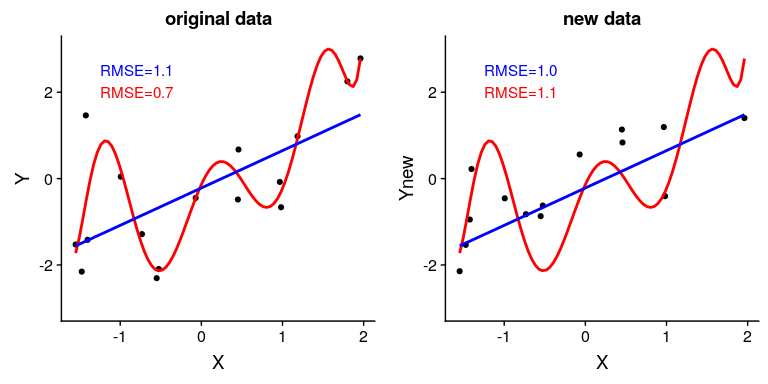## 5.4 模型是否太好?
錯誤聽起來像是一件壞事,通常我們更喜歡誤差較低的模型,而不是誤差較高的模型。然而,我們在上面提到,在模型精確地適應當前數據集的能力和它概括為新數據集的能力之間存在著一種張力,并且結果表明,誤差最小的模型在概括為新數據集時往往更糟糕!
為了看到這一點,讓我們再次生成一些數據,以便我們知道變量之間的真正關系。我們將創建兩個模擬數據集,它們以完全相同的方式生成——它們只是添加了不同的隨機噪聲。

圖 5.6 過擬合示例。兩個數據集都是使用相同的模型生成的,每個數據集都添加了不同的隨機噪聲。左面板顯示了用于擬合模型的數據,簡單的藍色線性擬合和復雜的(8 階多項式)紅色擬合。每個模型的均方根誤差值如圖所示;在這種情況下,復雜模型的 RMSE 比簡單模型低。右面板顯示了第二個數據集,上面覆蓋了相同的模型,并且使用從第一個數據集獲得的模型計算了 RMSE 值。在這里,我們看到更簡單的模型實際上比更復雜的模型更適合新的數據集,后者過度適合第一個數據集。
圖[5.6](#fig:Overfitting)中的左面板顯示,更復雜的模型(紅色)比簡單的模型(藍色)更適合數據。然而,當相同的模型應用于以相同方式生成的新數據集時,我們看到了相反的情況——這里我們看到,較簡單的模型比較復雜的模型更適合新數據。從直觀上看,較復雜的模型受第一個數據集中特定數據點的影響較大;由于這些數據點的確切位置受隨機噪聲的驅動,導致較復雜的模型很難適應新的數據集。這是一個我們稱之為 _ 過擬合 _ 的現象,我們將在本課程中反復討論。稍后,我們將學習一些技術,我們可以使用這些技術來防止過度擬合,同時仍然對數據結構敏感。現在,重要的是要記住,我們的模型適合需要是好的,但不是太好。正如阿爾伯特愛因斯坦(1933)所說:“幾乎不能否認,所有理論的最高目標是使不可約的基本要素盡可能簡單和少,而不必放棄對單一經驗數據的充分表示。”這通常被解釋為:“一切應該盡可能簡單,但不能簡單。”
- 前言
- 0.1 本書為什么存在?
- 0.2 你不是統計學家-我們為什么要聽你的?
- 0.3 為什么是 R?
- 0.4 數據的黃金時代
- 0.5 開源書籍
- 0.6 確認
- 1 引言
- 1.1 什么是統計思維?
- 1.2 統計數據能為我們做什么?
- 1.3 統計學的基本概念
- 1.4 因果關系與統計
- 1.5 閱讀建議
- 2 處理數據
- 2.1 什么是數據?
- 2.2 測量尺度
- 2.3 什么是良好的測量?
- 2.4 閱讀建議
- 3 概率
- 3.1 什么是概率?
- 3.2 我們如何確定概率?
- 3.3 概率分布
- 3.4 條件概率
- 3.5 根據數據計算條件概率
- 3.6 獨立性
- 3.7 逆轉條件概率:貝葉斯規則
- 3.8 數據學習
- 3.9 優勢比
- 3.10 概率是什么意思?
- 3.11 閱讀建議
- 4 匯總數據
- 4.1 為什么要總結數據?
- 4.2 使用表格匯總數據
- 4.3 分布的理想化表示
- 4.4 閱讀建議
- 5 將模型擬合到數據
- 5.1 什么是模型?
- 5.2 統計建模:示例
- 5.3 什么使模型“良好”?
- 5.4 模型是否太好?
- 5.5 最簡單的模型:平均值
- 5.6 模式
- 5.7 變異性:平均值與數據的擬合程度如何?
- 5.8 使用模擬了解統計數據
- 5.9 Z 分數
- 6 數據可視化
- 6.1 數據可視化如何拯救生命
- 6.2 繪圖解剖
- 6.3 使用 ggplot 在 R 中繪制
- 6.4 良好可視化原則
- 6.5 最大化數據/墨水比
- 6.6 避免圖表垃圾
- 6.7 避免數據失真
- 6.8 謊言因素
- 6.9 記住人的局限性
- 6.10 其他因素的修正
- 6.11 建議閱讀和視頻
- 7 取樣
- 7.1 我們如何取樣?
- 7.2 采樣誤差
- 7.3 平均值的標準誤差
- 7.4 中心極限定理
- 7.5 置信區間
- 7.6 閱讀建議
- 8 重新采樣和模擬
- 8.1 蒙特卡羅模擬
- 8.2 統計的隨機性
- 8.3 生成隨機數
- 8.4 使用蒙特卡羅模擬
- 8.5 使用模擬統計:引導程序
- 8.6 閱讀建議
- 9 假設檢驗
- 9.1 無效假設統計檢驗(NHST)
- 9.2 無效假設統計檢驗:一個例子
- 9.3 無效假設檢驗過程
- 9.4 現代環境下的 NHST:多重測試
- 9.5 閱讀建議
- 10 置信區間、效應大小和統計功率
- 10.1 置信區間
- 10.2 效果大小
- 10.3 統計能力
- 10.4 閱讀建議
- 11 貝葉斯統計
- 11.1 生成模型
- 11.2 貝葉斯定理與逆推理
- 11.3 進行貝葉斯估計
- 11.4 估計后驗分布
- 11.5 選擇優先權
- 11.6 貝葉斯假設檢驗
- 11.7 閱讀建議
- 12 分類關系建模
- 12.1 示例:糖果顏色
- 12.2 皮爾遜卡方檢驗
- 12.3 應急表及雙向試驗
- 12.4 標準化殘差
- 12.5 優勢比
- 12.6 貝葉斯系數
- 12.7 超出 2 x 2 表的分類分析
- 12.8 注意辛普森悖論
- 13 建模持續關系
- 13.1 一個例子:仇恨犯罪和收入不平等
- 13.2 收入不平等是否與仇恨犯罪有關?
- 13.3 協方差和相關性
- 13.4 相關性和因果關系
- 13.5 閱讀建議
- 14 一般線性模型
- 14.1 線性回歸
- 14.2 安裝更復雜的模型
- 14.3 變量之間的相互作用
- 14.4“預測”的真正含義是什么?
- 14.5 閱讀建議
- 15 比較方法
- 15.1 學生 T 考試
- 15.2 t 檢驗作為線性模型
- 15.3 平均差的貝葉斯因子
- 15.4 配對 t 檢驗
- 15.5 比較兩種以上的方法
- 16 統計建模過程:一個實例
- 16.1 統計建模過程
- 17 做重復性研究
- 17.1 我們認為科學應該如何運作
- 17.2 科學(有時)是如何工作的
- 17.3 科學中的再現性危機
- 17.4 有問題的研究實踐
- 17.5 進行重復性研究
- 17.6 進行重復性數據分析
- 17.7 結論:提高科學水平
- 17.8 閱讀建議
- References
